Taxation Law: Residency, Capital Gains, and Business Sale Analysis
VerifiedAdded on 2023/01/17
|14
|4275
|65
Homework Assignment
AI Summary
This taxation law assignment analyzes two scenarios: the residential status of a fashion designer, Hannah, and the tax implications of Ben selling his car dealership. The first part examines Hannah's residency, considering the resides test, domicile test, 183-day test, and Commonwealth superannuation fund test, concluding she is an Australian resident for tax purposes. The second part explores the sale of Ben's business as a going concern, including capital gains and potential tax liabilities. The analysis covers the components of the sale, including the car yard site, used cars, office equipment, goodwill, and a non-compete agreement, along with Ben's personal assets and debts. The assignment identifies the issue of how Ben can reduce his tax liability and the consequences of selling his business.
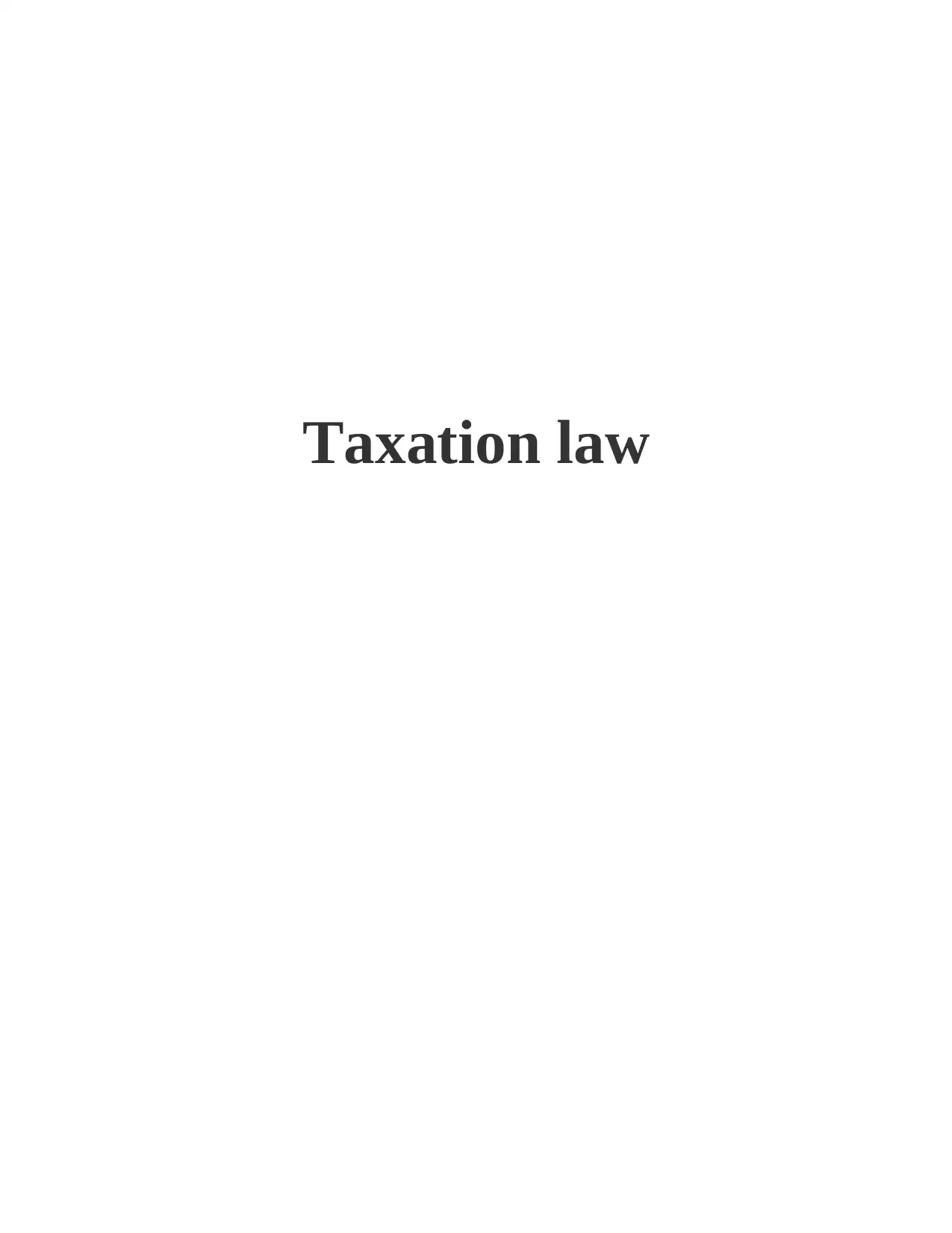
Taxation law
Paraphrase This Document
Need a fresh take? Get an instant paraphrase of this document with our AI Paraphraser
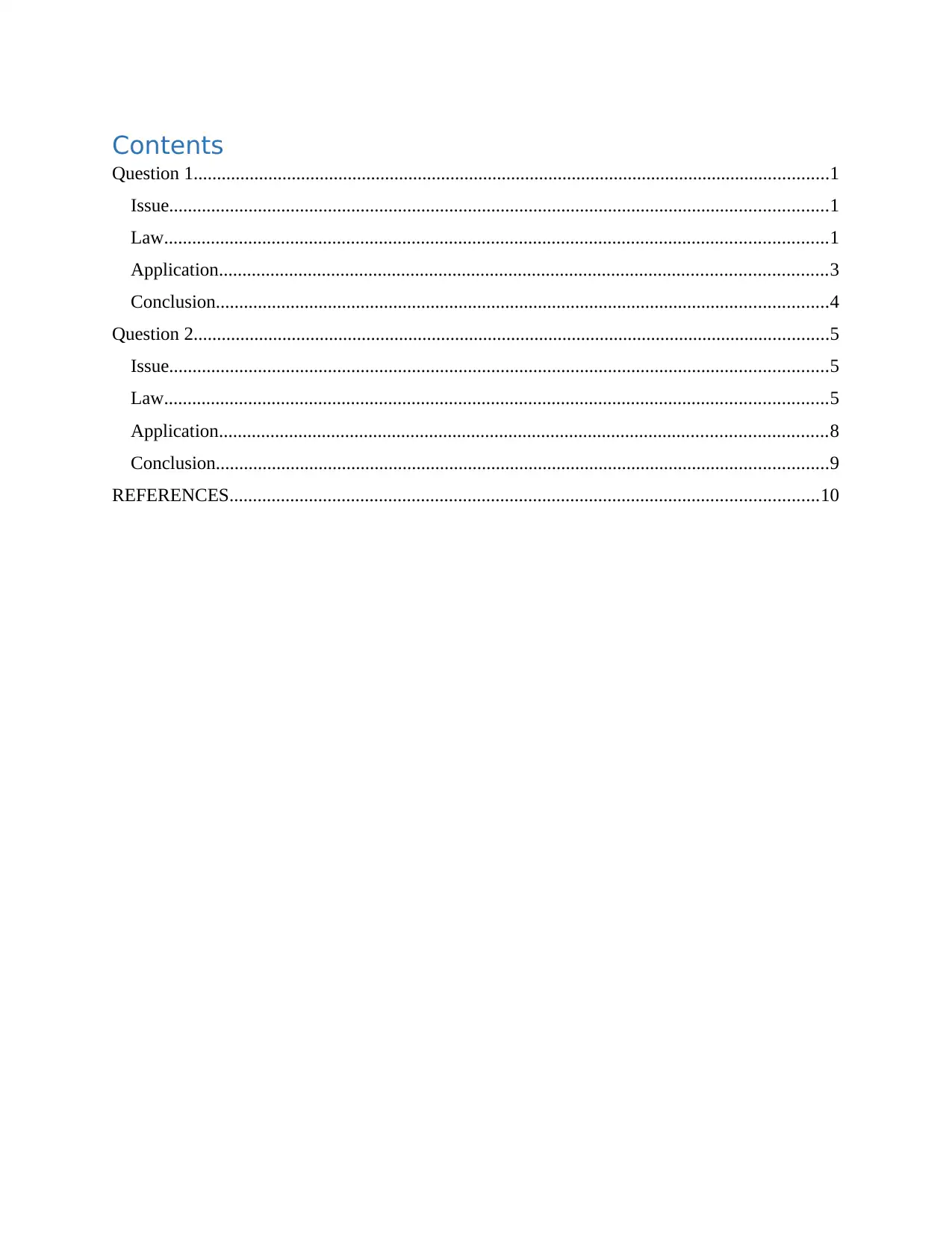
Contents
Question 1........................................................................................................................................1
Issue.............................................................................................................................................1
Law..............................................................................................................................................1
Application..................................................................................................................................3
Conclusion...................................................................................................................................4
Question 2........................................................................................................................................5
Issue.............................................................................................................................................5
Law..............................................................................................................................................5
Application..................................................................................................................................8
Conclusion...................................................................................................................................9
REFERENCES..............................................................................................................................10
Question 1........................................................................................................................................1
Issue.............................................................................................................................................1
Law..............................................................................................................................................1
Application..................................................................................................................................3
Conclusion...................................................................................................................................4
Question 2........................................................................................................................................5
Issue.............................................................................................................................................5
Law..............................................................................................................................................5
Application..................................................................................................................................8
Conclusion...................................................................................................................................9
REFERENCES..............................................................................................................................10

⊘ This is a preview!⊘
Do you want full access?
Subscribe today to unlock all pages.

Trusted by 1+ million students worldwide
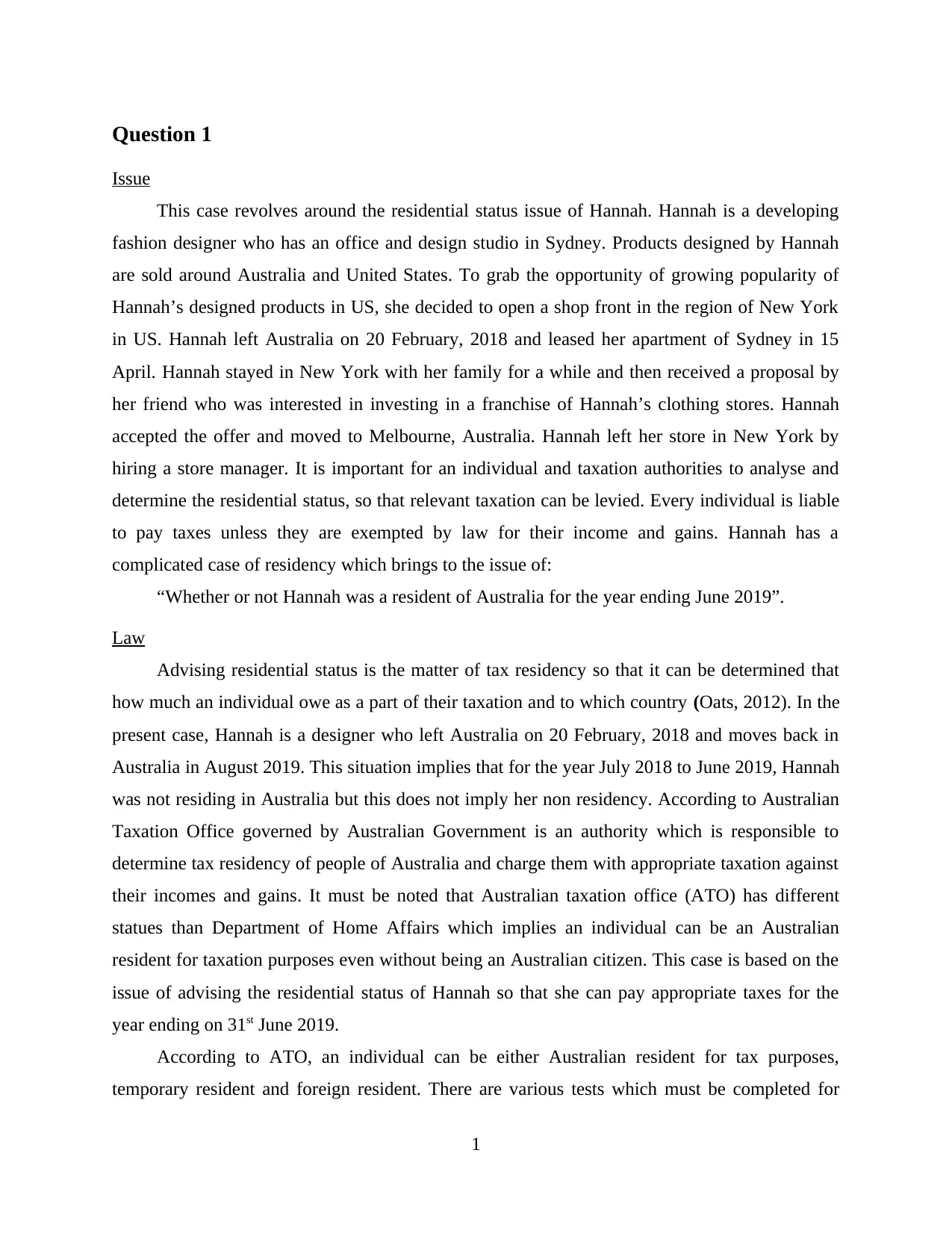
Question 1
Issue
This case revolves around the residential status issue of Hannah. Hannah is a developing
fashion designer who has an office and design studio in Sydney. Products designed by Hannah
are sold around Australia and United States. To grab the opportunity of growing popularity of
Hannah’s designed products in US, she decided to open a shop front in the region of New York
in US. Hannah left Australia on 20 February, 2018 and leased her apartment of Sydney in 15
April. Hannah stayed in New York with her family for a while and then received a proposal by
her friend who was interested in investing in a franchise of Hannah’s clothing stores. Hannah
accepted the offer and moved to Melbourne, Australia. Hannah left her store in New York by
hiring a store manager. It is important for an individual and taxation authorities to analyse and
determine the residential status, so that relevant taxation can be levied. Every individual is liable
to pay taxes unless they are exempted by law for their income and gains. Hannah has a
complicated case of residency which brings to the issue of:
“Whether or not Hannah was a resident of Australia for the year ending June 2019”.
Law
Advising residential status is the matter of tax residency so that it can be determined that
how much an individual owe as a part of their taxation and to which country (Oats, 2012). In the
present case, Hannah is a designer who left Australia on 20 February, 2018 and moves back in
Australia in August 2019. This situation implies that for the year July 2018 to June 2019, Hannah
was not residing in Australia but this does not imply her non residency. According to Australian
Taxation Office governed by Australian Government is an authority which is responsible to
determine tax residency of people of Australia and charge them with appropriate taxation against
their incomes and gains. It must be noted that Australian taxation office (ATO) has different
statues than Department of Home Affairs which implies an individual can be an Australian
resident for taxation purposes even without being an Australian citizen. This case is based on the
issue of advising the residential status of Hannah so that she can pay appropriate taxes for the
year ending on 31st June 2019.
According to ATO, an individual can be either Australian resident for tax purposes,
temporary resident and foreign resident. There are various tests which must be completed for
1
Issue
This case revolves around the residential status issue of Hannah. Hannah is a developing
fashion designer who has an office and design studio in Sydney. Products designed by Hannah
are sold around Australia and United States. To grab the opportunity of growing popularity of
Hannah’s designed products in US, she decided to open a shop front in the region of New York
in US. Hannah left Australia on 20 February, 2018 and leased her apartment of Sydney in 15
April. Hannah stayed in New York with her family for a while and then received a proposal by
her friend who was interested in investing in a franchise of Hannah’s clothing stores. Hannah
accepted the offer and moved to Melbourne, Australia. Hannah left her store in New York by
hiring a store manager. It is important for an individual and taxation authorities to analyse and
determine the residential status, so that relevant taxation can be levied. Every individual is liable
to pay taxes unless they are exempted by law for their income and gains. Hannah has a
complicated case of residency which brings to the issue of:
“Whether or not Hannah was a resident of Australia for the year ending June 2019”.
Law
Advising residential status is the matter of tax residency so that it can be determined that
how much an individual owe as a part of their taxation and to which country (Oats, 2012). In the
present case, Hannah is a designer who left Australia on 20 February, 2018 and moves back in
Australia in August 2019. This situation implies that for the year July 2018 to June 2019, Hannah
was not residing in Australia but this does not imply her non residency. According to Australian
Taxation Office governed by Australian Government is an authority which is responsible to
determine tax residency of people of Australia and charge them with appropriate taxation against
their incomes and gains. It must be noted that Australian taxation office (ATO) has different
statues than Department of Home Affairs which implies an individual can be an Australian
resident for taxation purposes even without being an Australian citizen. This case is based on the
issue of advising the residential status of Hannah so that she can pay appropriate taxes for the
year ending on 31st June 2019.
According to ATO, an individual can be either Australian resident for tax purposes,
temporary resident and foreign resident. There are various tests which must be completed for
1
Paraphrase This Document
Need a fresh take? Get an instant paraphrase of this document with our AI Paraphraser
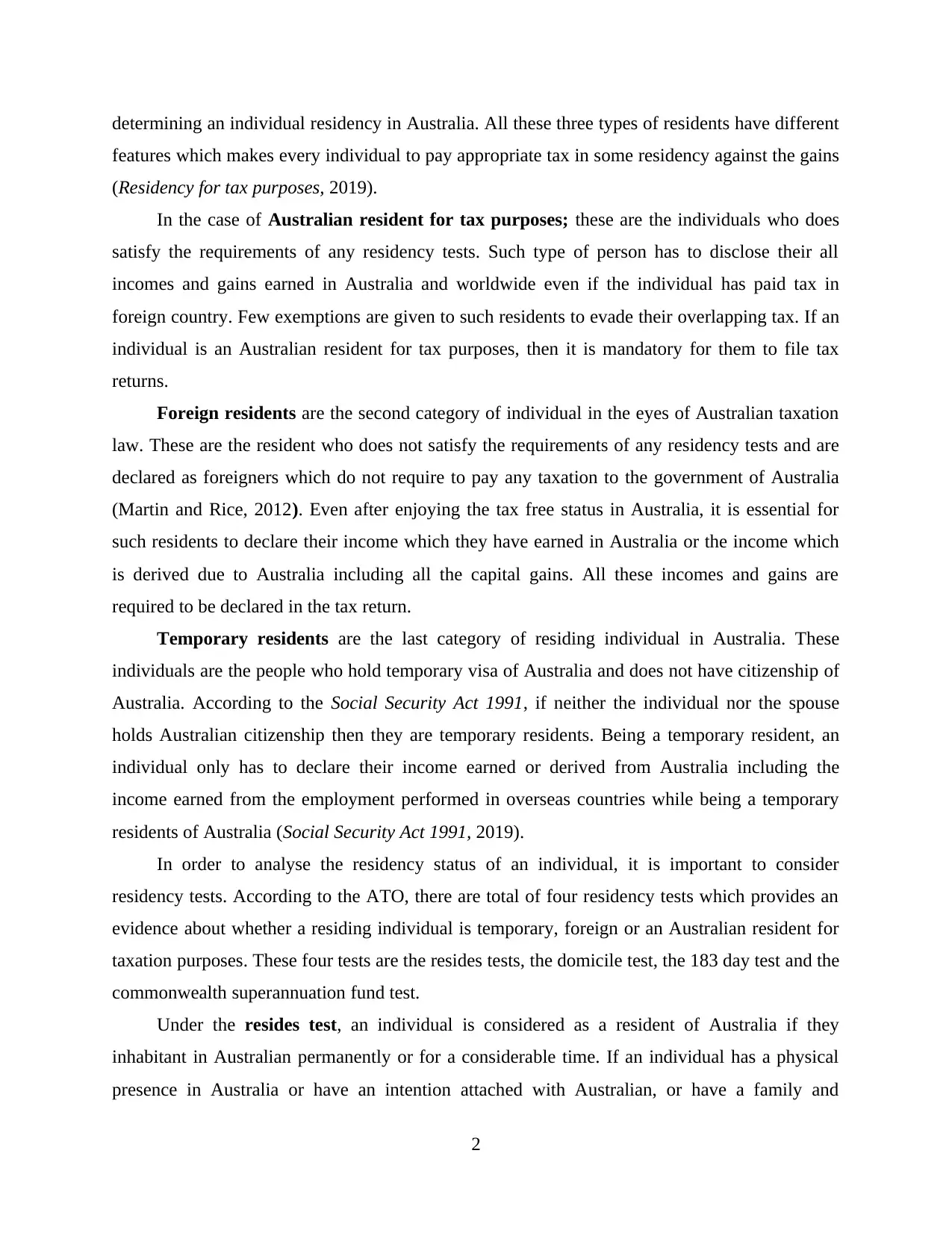
determining an individual residency in Australia. All these three types of residents have different
features which makes every individual to pay appropriate tax in some residency against the gains
(Residency for tax purposes, 2019).
In the case of Australian resident for tax purposes; these are the individuals who does
satisfy the requirements of any residency tests. Such type of person has to disclose their all
incomes and gains earned in Australia and worldwide even if the individual has paid tax in
foreign country. Few exemptions are given to such residents to evade their overlapping tax. If an
individual is an Australian resident for tax purposes, then it is mandatory for them to file tax
returns.
Foreign residents are the second category of individual in the eyes of Australian taxation
law. These are the resident who does not satisfy the requirements of any residency tests and are
declared as foreigners which do not require to pay any taxation to the government of Australia
(Martin and Rice, 2012). Even after enjoying the tax free status in Australia, it is essential for
such residents to declare their income which they have earned in Australia or the income which
is derived due to Australia including all the capital gains. All these incomes and gains are
required to be declared in the tax return.
Temporary residents are the last category of residing individual in Australia. These
individuals are the people who hold temporary visa of Australia and does not have citizenship of
Australia. According to the Social Security Act 1991, if neither the individual nor the spouse
holds Australian citizenship then they are temporary residents. Being a temporary resident, an
individual only has to declare their income earned or derived from Australia including the
income earned from the employment performed in overseas countries while being a temporary
residents of Australia (Social Security Act 1991, 2019).
In order to analyse the residency status of an individual, it is important to consider
residency tests. According to the ATO, there are total of four residency tests which provides an
evidence about whether a residing individual is temporary, foreign or an Australian resident for
taxation purposes. These four tests are the resides tests, the domicile test, the 183 day test and the
commonwealth superannuation fund test.
Under the resides test, an individual is considered as a resident of Australia if they
inhabitant in Australian permanently or for a considerable time. If an individual has a physical
presence in Australia or have an intention attached with Australian, or have a family and
2
features which makes every individual to pay appropriate tax in some residency against the gains
(Residency for tax purposes, 2019).
In the case of Australian resident for tax purposes; these are the individuals who does
satisfy the requirements of any residency tests. Such type of person has to disclose their all
incomes and gains earned in Australia and worldwide even if the individual has paid tax in
foreign country. Few exemptions are given to such residents to evade their overlapping tax. If an
individual is an Australian resident for tax purposes, then it is mandatory for them to file tax
returns.
Foreign residents are the second category of individual in the eyes of Australian taxation
law. These are the resident who does not satisfy the requirements of any residency tests and are
declared as foreigners which do not require to pay any taxation to the government of Australia
(Martin and Rice, 2012). Even after enjoying the tax free status in Australia, it is essential for
such residents to declare their income which they have earned in Australia or the income which
is derived due to Australia including all the capital gains. All these incomes and gains are
required to be declared in the tax return.
Temporary residents are the last category of residing individual in Australia. These
individuals are the people who hold temporary visa of Australia and does not have citizenship of
Australia. According to the Social Security Act 1991, if neither the individual nor the spouse
holds Australian citizenship then they are temporary residents. Being a temporary resident, an
individual only has to declare their income earned or derived from Australia including the
income earned from the employment performed in overseas countries while being a temporary
residents of Australia (Social Security Act 1991, 2019).
In order to analyse the residency status of an individual, it is important to consider
residency tests. According to the ATO, there are total of four residency tests which provides an
evidence about whether a residing individual is temporary, foreign or an Australian resident for
taxation purposes. These four tests are the resides tests, the domicile test, the 183 day test and the
commonwealth superannuation fund test.
Under the resides test, an individual is considered as a resident of Australia if they
inhabitant in Australian permanently or for a considerable time. If an individual has a physical
presence in Australia or have an intention attached with Australian, or have a family and
2
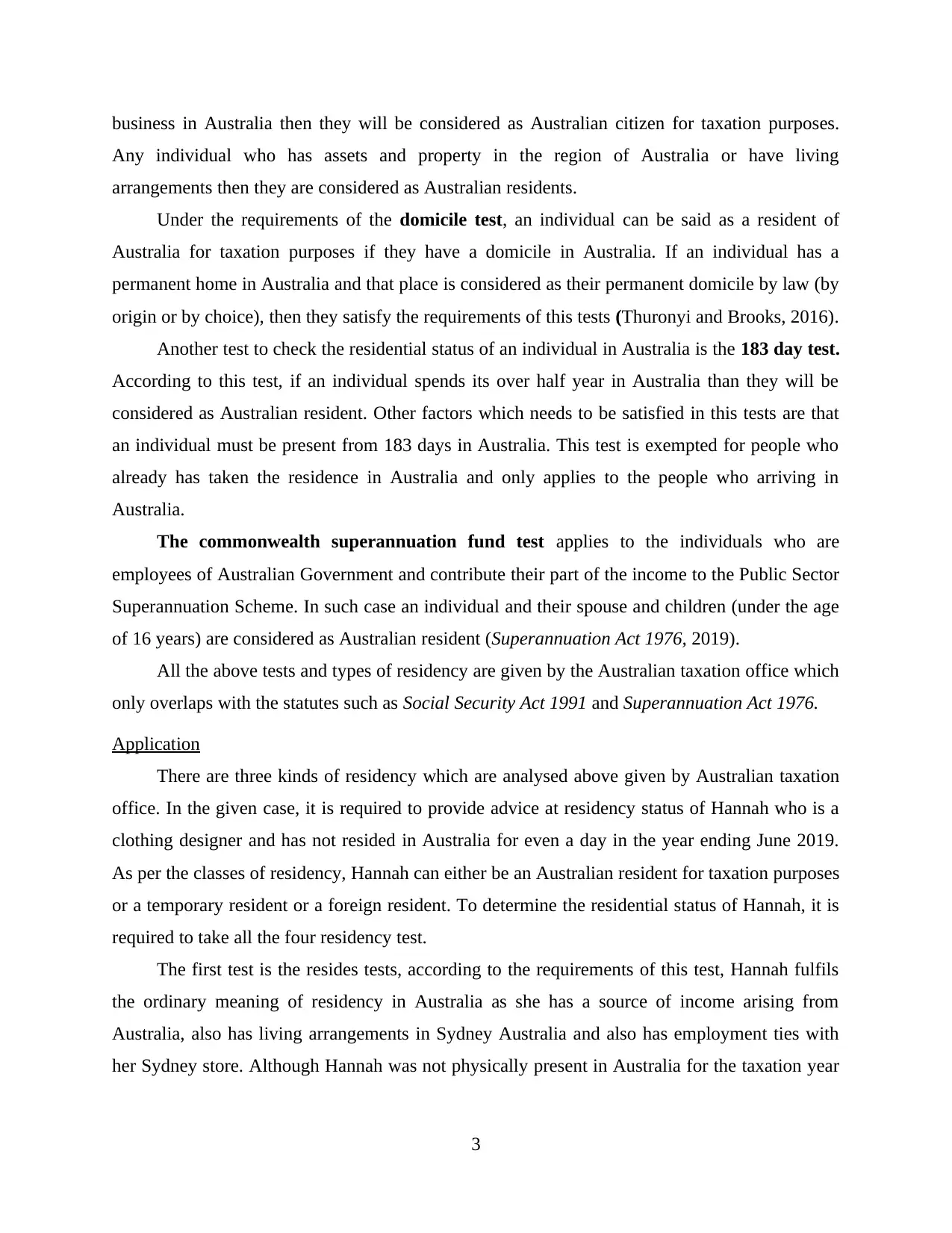
business in Australia then they will be considered as Australian citizen for taxation purposes.
Any individual who has assets and property in the region of Australia or have living
arrangements then they are considered as Australian residents.
Under the requirements of the domicile test, an individual can be said as a resident of
Australia for taxation purposes if they have a domicile in Australia. If an individual has a
permanent home in Australia and that place is considered as their permanent domicile by law (by
origin or by choice), then they satisfy the requirements of this tests (Thuronyi and Brooks, 2016).
Another test to check the residential status of an individual in Australia is the 183 day test.
According to this test, if an individual spends its over half year in Australia than they will be
considered as Australian resident. Other factors which needs to be satisfied in this tests are that
an individual must be present from 183 days in Australia. This test is exempted for people who
already has taken the residence in Australia and only applies to the people who arriving in
Australia.
The commonwealth superannuation fund test applies to the individuals who are
employees of Australian Government and contribute their part of the income to the Public Sector
Superannuation Scheme. In such case an individual and their spouse and children (under the age
of 16 years) are considered as Australian resident (Superannuation Act 1976, 2019).
All the above tests and types of residency are given by the Australian taxation office which
only overlaps with the statutes such as Social Security Act 1991 and Superannuation Act 1976.
Application
There are three kinds of residency which are analysed above given by Australian taxation
office. In the given case, it is required to provide advice at residency status of Hannah who is a
clothing designer and has not resided in Australia for even a day in the year ending June 2019.
As per the classes of residency, Hannah can either be an Australian resident for taxation purposes
or a temporary resident or a foreign resident. To determine the residential status of Hannah, it is
required to take all the four residency test.
The first test is the resides tests, according to the requirements of this test, Hannah fulfils
the ordinary meaning of residency in Australia as she has a source of income arising from
Australia, also has living arrangements in Sydney Australia and also has employment ties with
her Sydney store. Although Hannah was not physically present in Australia for the taxation year
3
Any individual who has assets and property in the region of Australia or have living
arrangements then they are considered as Australian residents.
Under the requirements of the domicile test, an individual can be said as a resident of
Australia for taxation purposes if they have a domicile in Australia. If an individual has a
permanent home in Australia and that place is considered as their permanent domicile by law (by
origin or by choice), then they satisfy the requirements of this tests (Thuronyi and Brooks, 2016).
Another test to check the residential status of an individual in Australia is the 183 day test.
According to this test, if an individual spends its over half year in Australia than they will be
considered as Australian resident. Other factors which needs to be satisfied in this tests are that
an individual must be present from 183 days in Australia. This test is exempted for people who
already has taken the residence in Australia and only applies to the people who arriving in
Australia.
The commonwealth superannuation fund test applies to the individuals who are
employees of Australian Government and contribute their part of the income to the Public Sector
Superannuation Scheme. In such case an individual and their spouse and children (under the age
of 16 years) are considered as Australian resident (Superannuation Act 1976, 2019).
All the above tests and types of residency are given by the Australian taxation office which
only overlaps with the statutes such as Social Security Act 1991 and Superannuation Act 1976.
Application
There are three kinds of residency which are analysed above given by Australian taxation
office. In the given case, it is required to provide advice at residency status of Hannah who is a
clothing designer and has not resided in Australia for even a day in the year ending June 2019.
As per the classes of residency, Hannah can either be an Australian resident for taxation purposes
or a temporary resident or a foreign resident. To determine the residential status of Hannah, it is
required to take all the four residency test.
The first test is the resides tests, according to the requirements of this test, Hannah fulfils
the ordinary meaning of residency in Australia as she has a source of income arising from
Australia, also has living arrangements in Sydney Australia and also has employment ties with
her Sydney store. Although Hannah was not physically present in Australia for the taxation year
3
⊘ This is a preview!⊘
Do you want full access?
Subscribe today to unlock all pages.

Trusted by 1+ million students worldwide
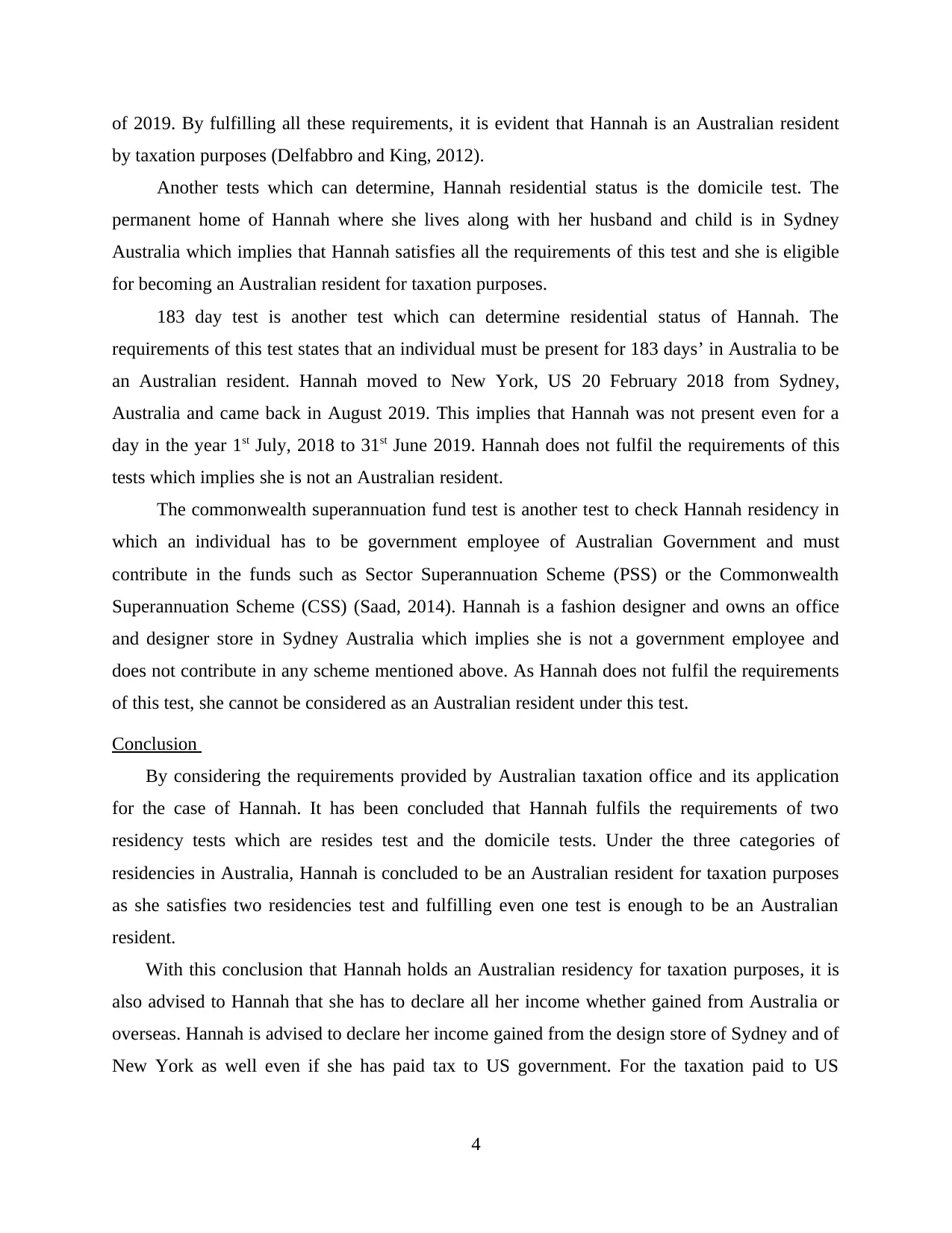
of 2019. By fulfilling all these requirements, it is evident that Hannah is an Australian resident
by taxation purposes (Delfabbro and King, 2012).
Another tests which can determine, Hannah residential status is the domicile test. The
permanent home of Hannah where she lives along with her husband and child is in Sydney
Australia which implies that Hannah satisfies all the requirements of this test and she is eligible
for becoming an Australian resident for taxation purposes.
183 day test is another test which can determine residential status of Hannah. The
requirements of this test states that an individual must be present for 183 days’ in Australia to be
an Australian resident. Hannah moved to New York, US 20 February 2018 from Sydney,
Australia and came back in August 2019. This implies that Hannah was not present even for a
day in the year 1st July, 2018 to 31st June 2019. Hannah does not fulfil the requirements of this
tests which implies she is not an Australian resident.
The commonwealth superannuation fund test is another test to check Hannah residency in
which an individual has to be government employee of Australian Government and must
contribute in the funds such as Sector Superannuation Scheme (PSS) or the Commonwealth
Superannuation Scheme (CSS) (Saad, 2014). Hannah is a fashion designer and owns an office
and designer store in Sydney Australia which implies she is not a government employee and
does not contribute in any scheme mentioned above. As Hannah does not fulfil the requirements
of this test, she cannot be considered as an Australian resident under this test.
Conclusion
By considering the requirements provided by Australian taxation office and its application
for the case of Hannah. It has been concluded that Hannah fulfils the requirements of two
residency tests which are resides test and the domicile tests. Under the three categories of
residencies in Australia, Hannah is concluded to be an Australian resident for taxation purposes
as she satisfies two residencies test and fulfilling even one test is enough to be an Australian
resident.
With this conclusion that Hannah holds an Australian residency for taxation purposes, it is
also advised to Hannah that she has to declare all her income whether gained from Australia or
overseas. Hannah is advised to declare her income gained from the design store of Sydney and of
New York as well even if she has paid tax to US government. For the taxation paid to US
4
by taxation purposes (Delfabbro and King, 2012).
Another tests which can determine, Hannah residential status is the domicile test. The
permanent home of Hannah where she lives along with her husband and child is in Sydney
Australia which implies that Hannah satisfies all the requirements of this test and she is eligible
for becoming an Australian resident for taxation purposes.
183 day test is another test which can determine residential status of Hannah. The
requirements of this test states that an individual must be present for 183 days’ in Australia to be
an Australian resident. Hannah moved to New York, US 20 February 2018 from Sydney,
Australia and came back in August 2019. This implies that Hannah was not present even for a
day in the year 1st July, 2018 to 31st June 2019. Hannah does not fulfil the requirements of this
tests which implies she is not an Australian resident.
The commonwealth superannuation fund test is another test to check Hannah residency in
which an individual has to be government employee of Australian Government and must
contribute in the funds such as Sector Superannuation Scheme (PSS) or the Commonwealth
Superannuation Scheme (CSS) (Saad, 2014). Hannah is a fashion designer and owns an office
and designer store in Sydney Australia which implies she is not a government employee and
does not contribute in any scheme mentioned above. As Hannah does not fulfil the requirements
of this test, she cannot be considered as an Australian resident under this test.
Conclusion
By considering the requirements provided by Australian taxation office and its application
for the case of Hannah. It has been concluded that Hannah fulfils the requirements of two
residency tests which are resides test and the domicile tests. Under the three categories of
residencies in Australia, Hannah is concluded to be an Australian resident for taxation purposes
as she satisfies two residencies test and fulfilling even one test is enough to be an Australian
resident.
With this conclusion that Hannah holds an Australian residency for taxation purposes, it is
also advised to Hannah that she has to declare all her income whether gained from Australia or
overseas. Hannah is advised to declare her income gained from the design store of Sydney and of
New York as well even if she has paid tax to US government. For the taxation paid to US
4
Paraphrase This Document
Need a fresh take? Get an instant paraphrase of this document with our AI Paraphraser
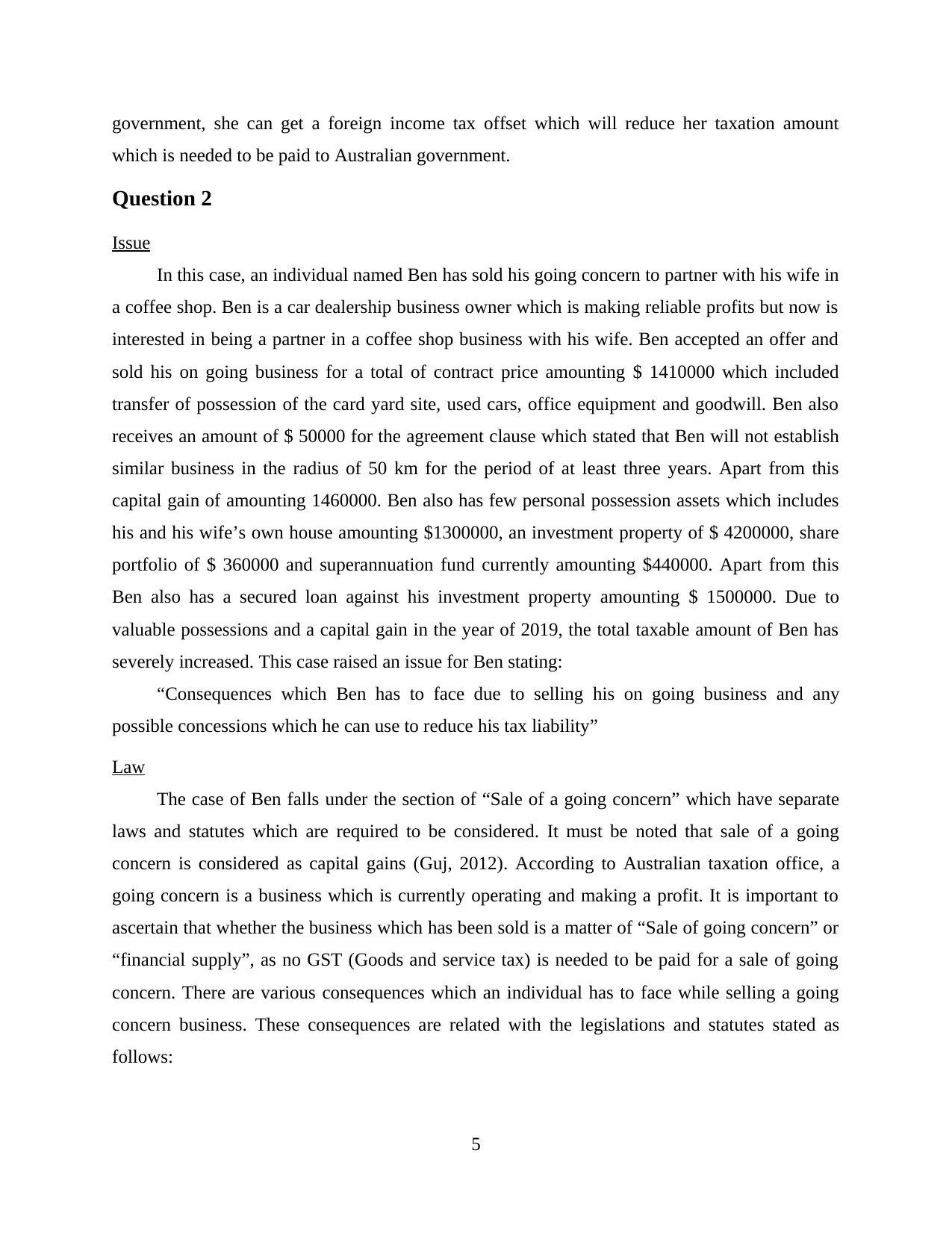
government, she can get a foreign income tax offset which will reduce her taxation amount
which is needed to be paid to Australian government.
Question 2
Issue
In this case, an individual named Ben has sold his going concern to partner with his wife in
a coffee shop. Ben is a car dealership business owner which is making reliable profits but now is
interested in being a partner in a coffee shop business with his wife. Ben accepted an offer and
sold his on going business for a total of contract price amounting $ 1410000 which included
transfer of possession of the card yard site, used cars, office equipment and goodwill. Ben also
receives an amount of $ 50000 for the agreement clause which stated that Ben will not establish
similar business in the radius of 50 km for the period of at least three years. Apart from this
capital gain of amounting 1460000. Ben also has few personal possession assets which includes
his and his wife’s own house amounting $1300000, an investment property of $ 4200000, share
portfolio of $ 360000 and superannuation fund currently amounting $440000. Apart from this
Ben also has a secured loan against his investment property amounting $ 1500000. Due to
valuable possessions and a capital gain in the year of 2019, the total taxable amount of Ben has
severely increased. This case raised an issue for Ben stating:
“Consequences which Ben has to face due to selling his on going business and any
possible concessions which he can use to reduce his tax liability”
Law
The case of Ben falls under the section of “Sale of a going concern” which have separate
laws and statutes which are required to be considered. It must be noted that sale of a going
concern is considered as capital gains (Guj, 2012). According to Australian taxation office, a
going concern is a business which is currently operating and making a profit. It is important to
ascertain that whether the business which has been sold is a matter of “Sale of going concern” or
“financial supply”, as no GST (Goods and service tax) is needed to be paid for a sale of going
concern. There are various consequences which an individual has to face while selling a going
concern business. These consequences are related with the legislations and statutes stated as
follows:
5
which is needed to be paid to Australian government.
Question 2
Issue
In this case, an individual named Ben has sold his going concern to partner with his wife in
a coffee shop. Ben is a car dealership business owner which is making reliable profits but now is
interested in being a partner in a coffee shop business with his wife. Ben accepted an offer and
sold his on going business for a total of contract price amounting $ 1410000 which included
transfer of possession of the card yard site, used cars, office equipment and goodwill. Ben also
receives an amount of $ 50000 for the agreement clause which stated that Ben will not establish
similar business in the radius of 50 km for the period of at least three years. Apart from this
capital gain of amounting 1460000. Ben also has few personal possession assets which includes
his and his wife’s own house amounting $1300000, an investment property of $ 4200000, share
portfolio of $ 360000 and superannuation fund currently amounting $440000. Apart from this
Ben also has a secured loan against his investment property amounting $ 1500000. Due to
valuable possessions and a capital gain in the year of 2019, the total taxable amount of Ben has
severely increased. This case raised an issue for Ben stating:
“Consequences which Ben has to face due to selling his on going business and any
possible concessions which he can use to reduce his tax liability”
Law
The case of Ben falls under the section of “Sale of a going concern” which have separate
laws and statutes which are required to be considered. It must be noted that sale of a going
concern is considered as capital gains (Guj, 2012). According to Australian taxation office, a
going concern is a business which is currently operating and making a profit. It is important to
ascertain that whether the business which has been sold is a matter of “Sale of going concern” or
“financial supply”, as no GST (Goods and service tax) is needed to be paid for a sale of going
concern. There are various consequences which an individual has to face while selling a going
concern business. These consequences are related with the legislations and statutes stated as
follows:
5
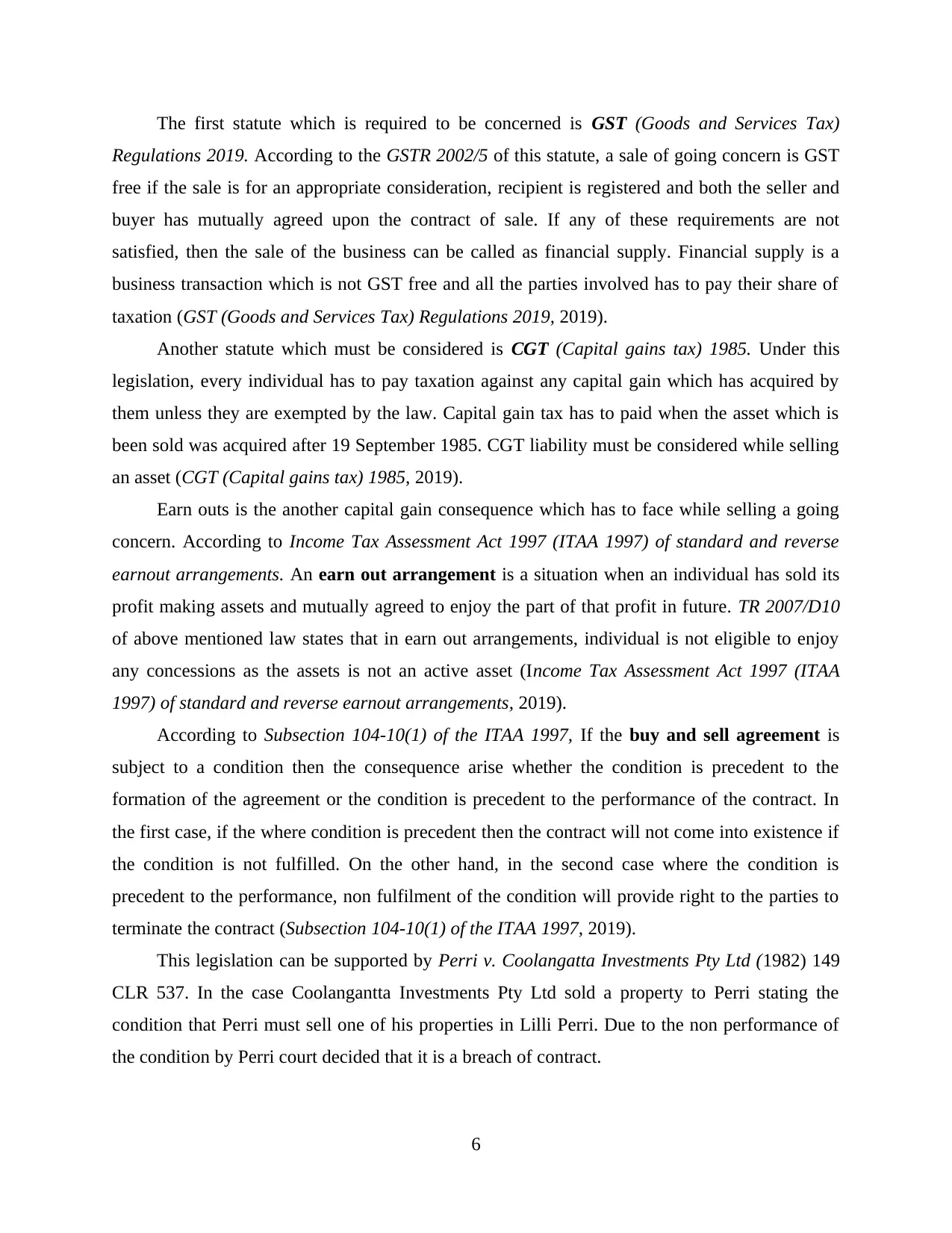
The first statute which is required to be concerned is GST (Goods and Services Tax)
Regulations 2019. According to the GSTR 2002/5 of this statute, a sale of going concern is GST
free if the sale is for an appropriate consideration, recipient is registered and both the seller and
buyer has mutually agreed upon the contract of sale. If any of these requirements are not
satisfied, then the sale of the business can be called as financial supply. Financial supply is a
business transaction which is not GST free and all the parties involved has to pay their share of
taxation (GST (Goods and Services Tax) Regulations 2019, 2019).
Another statute which must be considered is CGT (Capital gains tax) 1985. Under this
legislation, every individual has to pay taxation against any capital gain which has acquired by
them unless they are exempted by the law. Capital gain tax has to paid when the asset which is
been sold was acquired after 19 September 1985. CGT liability must be considered while selling
an asset (CGT (Capital gains tax) 1985, 2019).
Earn outs is the another capital gain consequence which has to face while selling a going
concern. According to Income Tax Assessment Act 1997 (ITAA 1997) of standard and reverse
earnout arrangements. An earn out arrangement is a situation when an individual has sold its
profit making assets and mutually agreed to enjoy the part of that profit in future. TR 2007/D10
of above mentioned law states that in earn out arrangements, individual is not eligible to enjoy
any concessions as the assets is not an active asset (Income Tax Assessment Act 1997 (ITAA
1997) of standard and reverse earnout arrangements, 2019).
According to Subsection 104-10(1) of the ITAA 1997, If the buy and sell agreement is
subject to a condition then the consequence arise whether the condition is precedent to the
formation of the agreement or the condition is precedent to the performance of the contract. In
the first case, if the where condition is precedent then the contract will not come into existence if
the condition is not fulfilled. On the other hand, in the second case where the condition is
precedent to the performance, non fulfilment of the condition will provide right to the parties to
terminate the contract (Subsection 104-10(1) of the ITAA 1997, 2019).
This legislation can be supported by Perri v. Coolangatta Investments Pty Ltd (1982) 149
CLR 537. In the case Coolangantta Investments Pty Ltd sold a property to Perri stating the
condition that Perri must sell one of his properties in Lilli Perri. Due to the non performance of
the condition by Perri court decided that it is a breach of contract.
6
Regulations 2019. According to the GSTR 2002/5 of this statute, a sale of going concern is GST
free if the sale is for an appropriate consideration, recipient is registered and both the seller and
buyer has mutually agreed upon the contract of sale. If any of these requirements are not
satisfied, then the sale of the business can be called as financial supply. Financial supply is a
business transaction which is not GST free and all the parties involved has to pay their share of
taxation (GST (Goods and Services Tax) Regulations 2019, 2019).
Another statute which must be considered is CGT (Capital gains tax) 1985. Under this
legislation, every individual has to pay taxation against any capital gain which has acquired by
them unless they are exempted by the law. Capital gain tax has to paid when the asset which is
been sold was acquired after 19 September 1985. CGT liability must be considered while selling
an asset (CGT (Capital gains tax) 1985, 2019).
Earn outs is the another capital gain consequence which has to face while selling a going
concern. According to Income Tax Assessment Act 1997 (ITAA 1997) of standard and reverse
earnout arrangements. An earn out arrangement is a situation when an individual has sold its
profit making assets and mutually agreed to enjoy the part of that profit in future. TR 2007/D10
of above mentioned law states that in earn out arrangements, individual is not eligible to enjoy
any concessions as the assets is not an active asset (Income Tax Assessment Act 1997 (ITAA
1997) of standard and reverse earnout arrangements, 2019).
According to Subsection 104-10(1) of the ITAA 1997, If the buy and sell agreement is
subject to a condition then the consequence arise whether the condition is precedent to the
formation of the agreement or the condition is precedent to the performance of the contract. In
the first case, if the where condition is precedent then the contract will not come into existence if
the condition is not fulfilled. On the other hand, in the second case where the condition is
precedent to the performance, non fulfilment of the condition will provide right to the parties to
terminate the contract (Subsection 104-10(1) of the ITAA 1997, 2019).
This legislation can be supported by Perri v. Coolangatta Investments Pty Ltd (1982) 149
CLR 537. In the case Coolangantta Investments Pty Ltd sold a property to Perri stating the
condition that Perri must sell one of his properties in Lilli Perri. Due to the non performance of
the condition by Perri court decided that it is a breach of contract.
6
⊘ This is a preview!⊘
Do you want full access?
Subscribe today to unlock all pages.

Trusted by 1+ million students worldwide
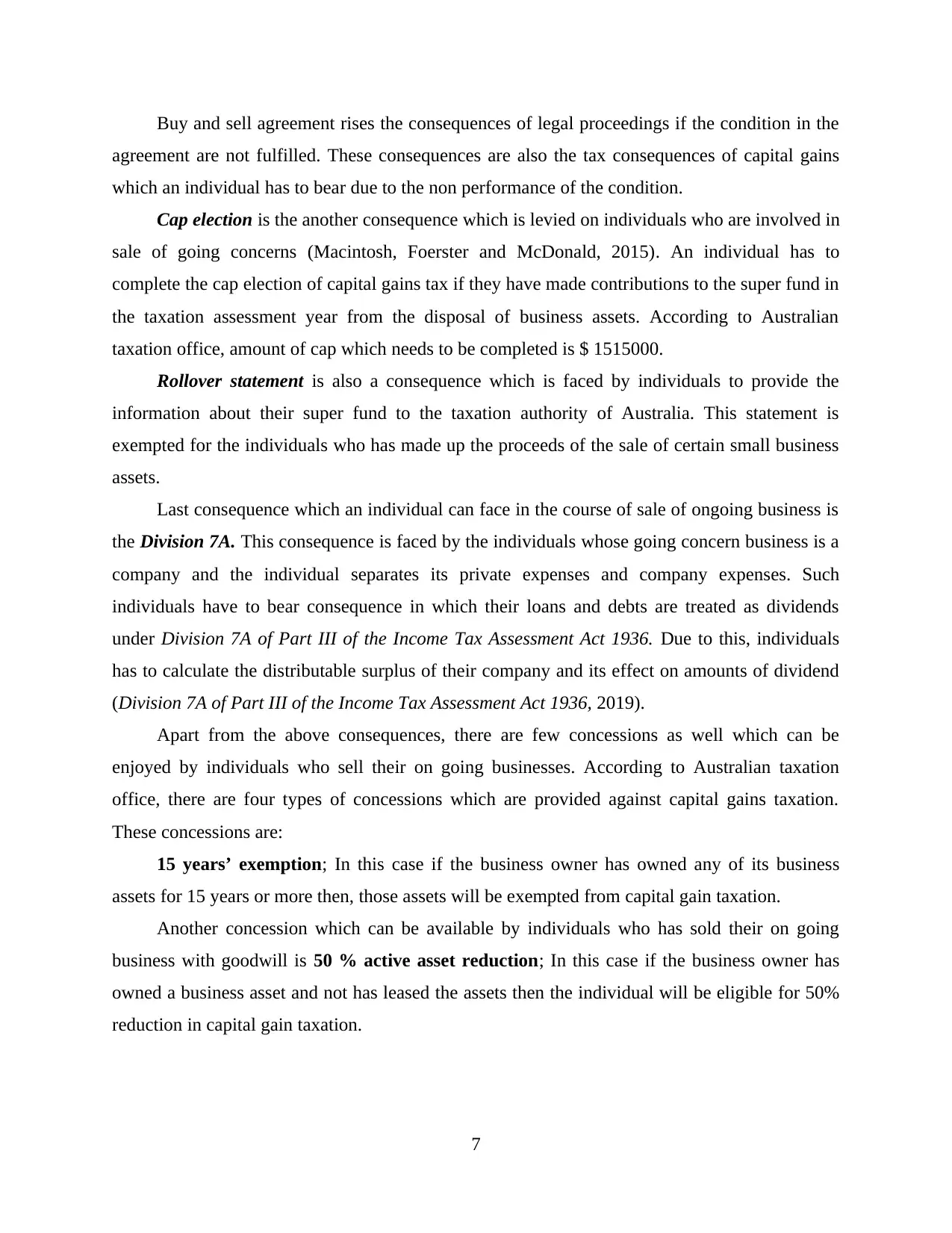
Buy and sell agreement rises the consequences of legal proceedings if the condition in the
agreement are not fulfilled. These consequences are also the tax consequences of capital gains
which an individual has to bear due to the non performance of the condition.
Cap election is the another consequence which is levied on individuals who are involved in
sale of going concerns (Macintosh, Foerster and McDonald, 2015). An individual has to
complete the cap election of capital gains tax if they have made contributions to the super fund in
the taxation assessment year from the disposal of business assets. According to Australian
taxation office, amount of cap which needs to be completed is $ 1515000.
Rollover statement is also a consequence which is faced by individuals to provide the
information about their super fund to the taxation authority of Australia. This statement is
exempted for the individuals who has made up the proceeds of the sale of certain small business
assets.
Last consequence which an individual can face in the course of sale of ongoing business is
the Division 7A. This consequence is faced by the individuals whose going concern business is a
company and the individual separates its private expenses and company expenses. Such
individuals have to bear consequence in which their loans and debts are treated as dividends
under Division 7A of Part III of the Income Tax Assessment Act 1936. Due to this, individuals
has to calculate the distributable surplus of their company and its effect on amounts of dividend
(Division 7A of Part III of the Income Tax Assessment Act 1936, 2019).
Apart from the above consequences, there are few concessions as well which can be
enjoyed by individuals who sell their on going businesses. According to Australian taxation
office, there are four types of concessions which are provided against capital gains taxation.
These concessions are:
15 years’ exemption; In this case if the business owner has owned any of its business
assets for 15 years or more then, those assets will be exempted from capital gain taxation.
Another concession which can be available by individuals who has sold their on going
business with goodwill is 50 % active asset reduction; In this case if the business owner has
owned a business asset and not has leased the assets then the individual will be eligible for 50%
reduction in capital gain taxation.
7
agreement are not fulfilled. These consequences are also the tax consequences of capital gains
which an individual has to bear due to the non performance of the condition.
Cap election is the another consequence which is levied on individuals who are involved in
sale of going concerns (Macintosh, Foerster and McDonald, 2015). An individual has to
complete the cap election of capital gains tax if they have made contributions to the super fund in
the taxation assessment year from the disposal of business assets. According to Australian
taxation office, amount of cap which needs to be completed is $ 1515000.
Rollover statement is also a consequence which is faced by individuals to provide the
information about their super fund to the taxation authority of Australia. This statement is
exempted for the individuals who has made up the proceeds of the sale of certain small business
assets.
Last consequence which an individual can face in the course of sale of ongoing business is
the Division 7A. This consequence is faced by the individuals whose going concern business is a
company and the individual separates its private expenses and company expenses. Such
individuals have to bear consequence in which their loans and debts are treated as dividends
under Division 7A of Part III of the Income Tax Assessment Act 1936. Due to this, individuals
has to calculate the distributable surplus of their company and its effect on amounts of dividend
(Division 7A of Part III of the Income Tax Assessment Act 1936, 2019).
Apart from the above consequences, there are few concessions as well which can be
enjoyed by individuals who sell their on going businesses. According to Australian taxation
office, there are four types of concessions which are provided against capital gains taxation.
These concessions are:
15 years’ exemption; In this case if the business owner has owned any of its business
assets for 15 years or more then, those assets will be exempted from capital gain taxation.
Another concession which can be available by individuals who has sold their on going
business with goodwill is 50 % active asset reduction; In this case if the business owner has
owned a business asset and not has leased the assets then the individual will be eligible for 50%
reduction in capital gain taxation.
7
Paraphrase This Document
Need a fresh take? Get an instant paraphrase of this document with our AI Paraphraser
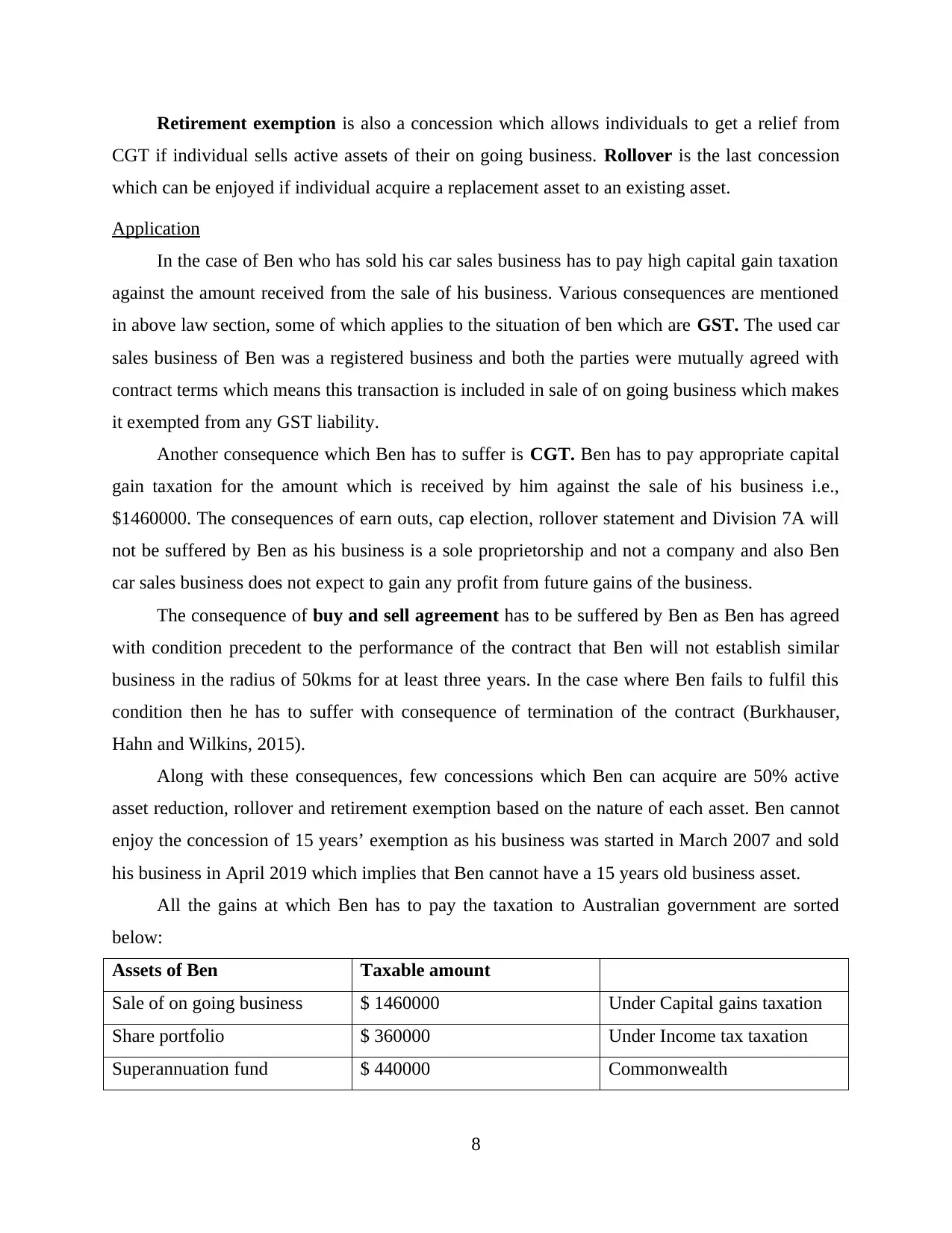
Retirement exemption is also a concession which allows individuals to get a relief from
CGT if individual sells active assets of their on going business. Rollover is the last concession
which can be enjoyed if individual acquire a replacement asset to an existing asset.
Application
In the case of Ben who has sold his car sales business has to pay high capital gain taxation
against the amount received from the sale of his business. Various consequences are mentioned
in above law section, some of which applies to the situation of ben which are GST. The used car
sales business of Ben was a registered business and both the parties were mutually agreed with
contract terms which means this transaction is included in sale of on going business which makes
it exempted from any GST liability.
Another consequence which Ben has to suffer is CGT. Ben has to pay appropriate capital
gain taxation for the amount which is received by him against the sale of his business i.e.,
$1460000. The consequences of earn outs, cap election, rollover statement and Division 7A will
not be suffered by Ben as his business is a sole proprietorship and not a company and also Ben
car sales business does not expect to gain any profit from future gains of the business.
The consequence of buy and sell agreement has to be suffered by Ben as Ben has agreed
with condition precedent to the performance of the contract that Ben will not establish similar
business in the radius of 50kms for at least three years. In the case where Ben fails to fulfil this
condition then he has to suffer with consequence of termination of the contract (Burkhauser,
Hahn and Wilkins, 2015).
Along with these consequences, few concessions which Ben can acquire are 50% active
asset reduction, rollover and retirement exemption based on the nature of each asset. Ben cannot
enjoy the concession of 15 years’ exemption as his business was started in March 2007 and sold
his business in April 2019 which implies that Ben cannot have a 15 years old business asset.
All the gains at which Ben has to pay the taxation to Australian government are sorted
below:
Assets of Ben Taxable amount
Sale of on going business $ 1460000 Under Capital gains taxation
Share portfolio $ 360000 Under Income tax taxation
Superannuation fund $ 440000 Commonwealth
8
CGT if individual sells active assets of their on going business. Rollover is the last concession
which can be enjoyed if individual acquire a replacement asset to an existing asset.
Application
In the case of Ben who has sold his car sales business has to pay high capital gain taxation
against the amount received from the sale of his business. Various consequences are mentioned
in above law section, some of which applies to the situation of ben which are GST. The used car
sales business of Ben was a registered business and both the parties were mutually agreed with
contract terms which means this transaction is included in sale of on going business which makes
it exempted from any GST liability.
Another consequence which Ben has to suffer is CGT. Ben has to pay appropriate capital
gain taxation for the amount which is received by him against the sale of his business i.e.,
$1460000. The consequences of earn outs, cap election, rollover statement and Division 7A will
not be suffered by Ben as his business is a sole proprietorship and not a company and also Ben
car sales business does not expect to gain any profit from future gains of the business.
The consequence of buy and sell agreement has to be suffered by Ben as Ben has agreed
with condition precedent to the performance of the contract that Ben will not establish similar
business in the radius of 50kms for at least three years. In the case where Ben fails to fulfil this
condition then he has to suffer with consequence of termination of the contract (Burkhauser,
Hahn and Wilkins, 2015).
Along with these consequences, few concessions which Ben can acquire are 50% active
asset reduction, rollover and retirement exemption based on the nature of each asset. Ben cannot
enjoy the concession of 15 years’ exemption as his business was started in March 2007 and sold
his business in April 2019 which implies that Ben cannot have a 15 years old business asset.
All the gains at which Ben has to pay the taxation to Australian government are sorted
below:
Assets of Ben Taxable amount
Sale of on going business $ 1460000 Under Capital gains taxation
Share portfolio $ 360000 Under Income tax taxation
Superannuation fund $ 440000 Commonwealth
8
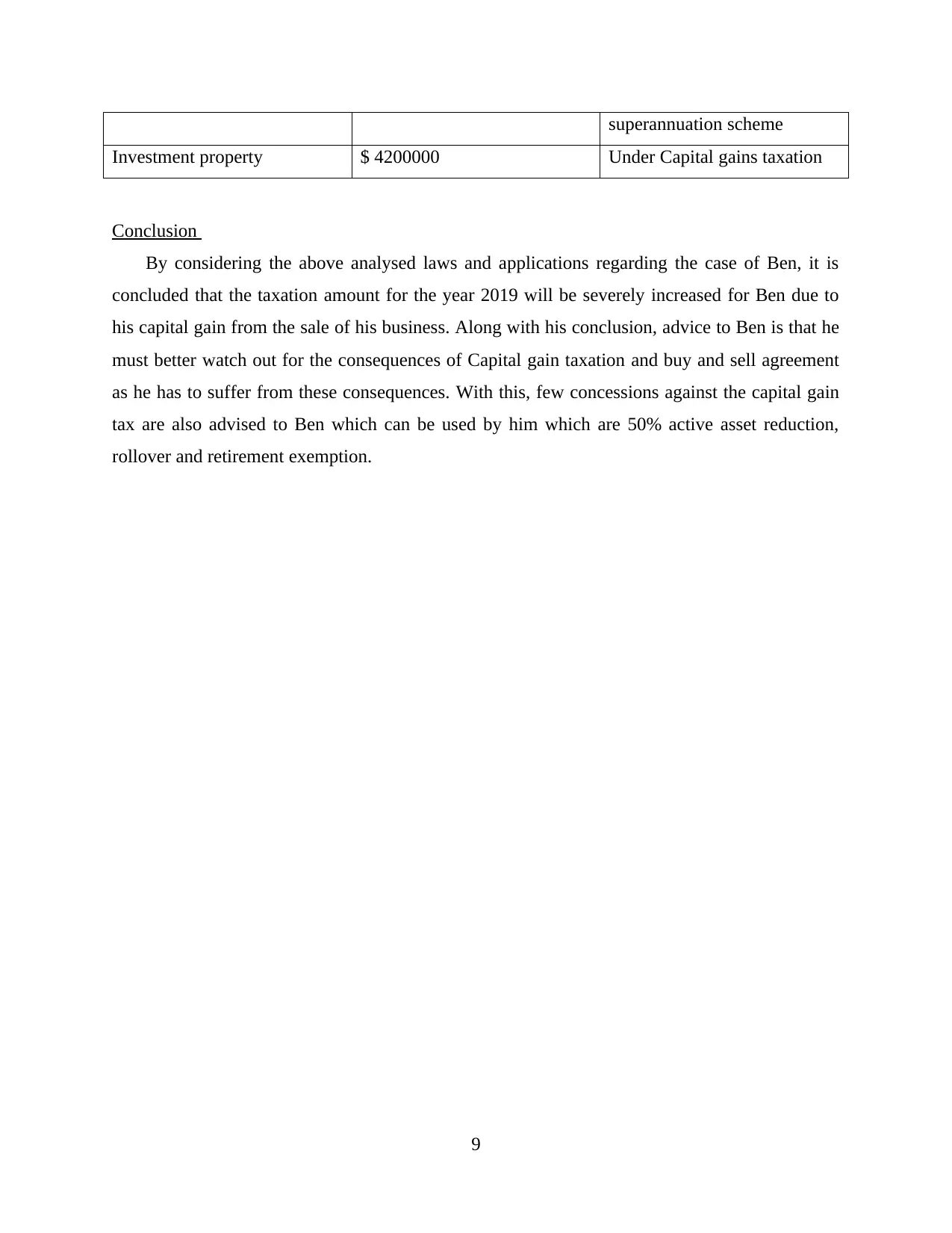
superannuation scheme
Investment property $ 4200000 Under Capital gains taxation
Conclusion
By considering the above analysed laws and applications regarding the case of Ben, it is
concluded that the taxation amount for the year 2019 will be severely increased for Ben due to
his capital gain from the sale of his business. Along with his conclusion, advice to Ben is that he
must better watch out for the consequences of Capital gain taxation and buy and sell agreement
as he has to suffer from these consequences. With this, few concessions against the capital gain
tax are also advised to Ben which can be used by him which are 50% active asset reduction,
rollover and retirement exemption.
9
Investment property $ 4200000 Under Capital gains taxation
Conclusion
By considering the above analysed laws and applications regarding the case of Ben, it is
concluded that the taxation amount for the year 2019 will be severely increased for Ben due to
his capital gain from the sale of his business. Along with his conclusion, advice to Ben is that he
must better watch out for the consequences of Capital gain taxation and buy and sell agreement
as he has to suffer from these consequences. With this, few concessions against the capital gain
tax are also advised to Ben which can be used by him which are 50% active asset reduction,
rollover and retirement exemption.
9
⊘ This is a preview!⊘
Do you want full access?
Subscribe today to unlock all pages.

Trusted by 1+ million students worldwide
1 out of 14
Related Documents
Your All-in-One AI-Powered Toolkit for Academic Success.
+13062052269
info@desklib.com
Available 24*7 on WhatsApp / Email
![[object Object]](/_next/static/media/star-bottom.7253800d.svg)
Unlock your academic potential
Copyright © 2020–2025 A2Z Services. All Rights Reserved. Developed and managed by ZUCOL.





